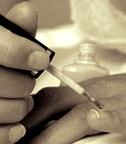Hand Problems
Chapped Hands
Dry, chapped hands are a real problem to anyone who enjoys the outdoors or does heavy housework.
Solution:
One solution is to use udder cream or Bag Balm.
Also consider using
It's based on formula from
Many perfectly polished beauties swear by traditional petroleum jelly as a protection.
Dry and Cracked Hands
During the winter season in most climates, heat is turned on and indoor humidity is very low. Add a few hand washings with soap and water during the day and you can easily develop hand problems
Solution:
The best treatment involves minimizing exposure to soap by using a non-soap cleanser. After hands have been exposed to water, apply a moisturizing lotion or cream. Better than lotion, mashed potatoes will solve this frequent problem.Boil a small peeled potato until soft.Mash with 1 tablespoon olive oil.Apply to hands and leave on for 15 minutes.Rinse with cool water.
For extremely chapped hands, use something you dip from a jar rather than squirt from a bottle. Wax- or paraffin-based products are excellent (the thicker the better). Nail glue works well to close painful cracks. Apply where needed and let it remain on the hands until it wears off naturally. After a minute or two the pain should be gone. Foot Problem
Foot Calluses
Calluses is a thickening of the outer layer of skin. This thickening is known medically as hyperkeratosis. Calluses develop as part of the skin's normal defense against prolonged rubbing, pressure and other forms of local irritation.

Solution:
Always use a pumice stone.
Razors and other cutters are now illegal for pedicurists to use. Avoid wearing high-heel shoes. For more on Calluses Management.
 Aching Feet
Aching Feet
When your feet hurt, you hurt all over because your feet are the base of your entire bone structure. Besides, Exhaustion and fatigue are not themselves disorders. They are symptoms and can be related to everything from stress to illness and diet.
Solution:
Practice picking up small objects like marbles or tiny balls with your toes.
Curl toes under, and hold that position for a few seconds.
Repeat several times.
Alternate walking on toes (like a ballerina) and heels every day.
Avoid high heels and tight shoes. It is best to wear wide, low-heeled shoes with soft soles. You could also look into getting custom shoe inserts called orthotics, which can help relieve the pressure and pain. (These may change the distribution of body weight on the bottoms of the feet and thus lessen any excessive pressure on the nerve.)
Nail Problems
Yellowed Nails
Yellowing of the nails could be caused by not using a base coat underneath your polish, or it could be a more serious nail fungus that needs to be treated.
Solution:
Lighten discolored nails with a whitening scrub containing a mild abrasive, or with a remover containing a lemon juice-like ingredient that bleaches out the yellow. To prevent the discoloration that occurs with nail polish stains, always use a base coat of superior quality.
Ridges
Ridges on the nail are, unfortunately, mostly genetic. However, if you have recently developed ridges, this could be a sign of anemia, and you should consult your doctor. Ridges may also be caused by too much pressure and pushing during your manicure.
 Solution:
Solution:
Though you can't change heredity, you can smooth the ridged nail surface with a buffer and buffing cream. When grooming your nails, always make an effort to be gentle on them so that they will grow back normally.
White Spots
White spots on the nail can be caused by a blow to the nail, applying too much pressure on the nail matrix during a manicure or too much pressure and pushing on the nail, generally.
Solution:
Let the spots grow out, and make an effort to be gentle when manicuring your nails since prodding beneath the cuticles, where new growth is generated, can cause these spots.
Pale Nails
Although pale nails can be hereditary, more often it is the result of poor circulation or anemia.
The nail beds become opaque, often leaving only a rim of pink nail bed at the top of the nail. The thumb and index nails bilaterally are the most involved.
Solution:
Take an iron supplement or add iron-rich foods to your diet.
Peeling Nails
Fingernails are simply another form of skin, composed primarily of a hardened protein called keratin. Illness, overuse of harsh detergents, nail glue and acetone remover, faulty filing, too much exposure to water are basic causes for peeling nails.
Solution:
Avoid quick-dry polishes that contain acetone, which can dry out your nails.
A better treatment to ensure healthy and strong nails is to rub hand cream and nail oil into the cuticles and base of the nails after every time you wash your hands. Always file nails lightly, just enough to shape and keep the layers even.
Uneven nails have a tendency to peel.






















